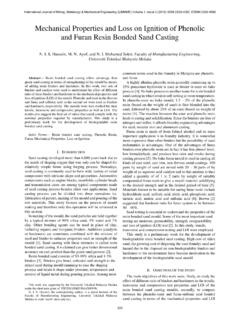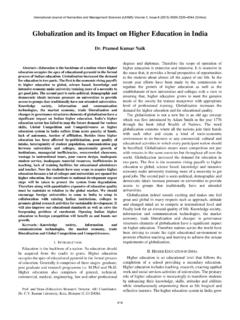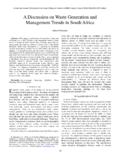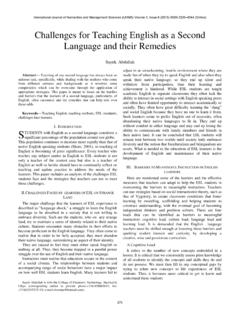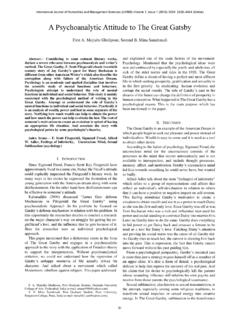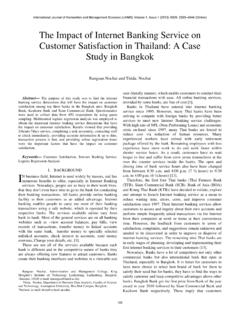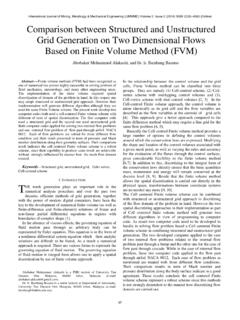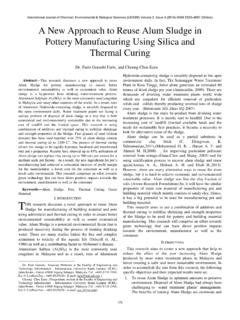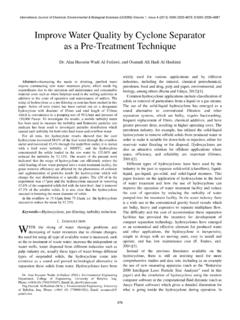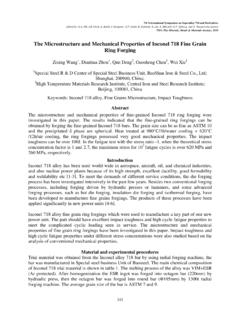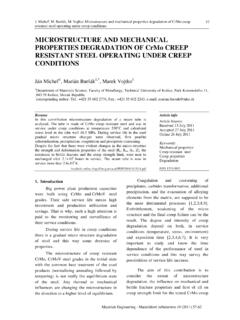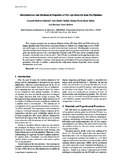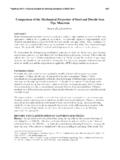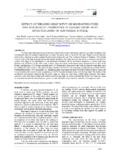Transcription of Effect of Fiber Orientation for Fiber Glass …
1 Abstract This study was designed to evaluate the Effect of Glass Fiber Orientation of reinforced composite material on mechanical properties :tensile strength, hardness ,toughness, also microstructure were tested .The study used to compare the Effect of direction of fibers in order to improve strength and toughness , this done by using two types of fibers (Eglass type) :continuous and discontinuous( sheets ) , Epoxy resin of (S553) is almost totally transparent when cured ,two dimensional Fiber reinforced polymer are characterized by a laminated structure in which the fibers are only aligned along the plane in x-direction and y direction of the material.
2 During test specimens were taken in three direction :parallel to Fiber direction , perpendicular and with angle = 45 for continuous Fiber and randomly specimen for discontinuous Fiber .This study show that best strength are when Fiber perpendicular to tensile force then with angle 45 then the parallel direction and all this is less than discontinuous type strength ,hardness be effected directly to number of laminated fabricated . Finally strength are increased when Fiber volume fraction increase unless exceed 30% of composite material.
3 Keywords RESIN, Fiber Glass , COMPOSITE MATERIAL, TENSILE , HARDNESS I. INTRODUCTION COMPOSITE material is a macroscopic combination of two or more distinct materials, having a recognizable interface between them. Composite laminate is a combination of Fiber and resin mixed in proper form. One of the unique properties of composite laminate is that it has high specific strength. Composites are being utilized as viable alternatives to metallic materials in structures where weight is a major consideration, , aerospace structures, high speed boats and trains.
4 Fiberglass is a composite material consisting of Glass fibers in a matrix of epoxy. The Glass fibers as purchased are woven into cloth, which is categorized by weight per square yard, type of weave, and type of Glass . There are several types of epoxy available. The mechanical properties of the fiberglass depend on the volume ratio of the two components as well as Ban. Bakir was in University of Baghdad, College of Engineering, Mechanical Department ,Iraq ,Baghdad e-mail Haithem. Hashemr was in University of Baghdad, College of Engineering, Mechanical Department, Iraq, Baghdad e-mail on the properties of the Glass Fiber component and the epoxy component individually Fiberglass similar to what is tested will be used as the outer skin of the rocket airframe.
5 Its purpose will be to stabilize and protect the airframe by serving as a stiffening component. In addition, the smooth surface of the fiberglass will serve to reduce drag on the rocket during flight. The fiberglass skin will experience bending, compression and tension loads during the supersonic flight. [1] Many researchers studied in this field, showed that the Orientation of fibers had a major role in increasing some properties, Balkees [2] shows that it increasing the creep resistance according to applied load, microstructure of the composite, and adhesion between the resin and the fibers.
6 Lee & Jyongsik [3] reported that as Fiber content increased, the tensile and flextural modulus of the Glass Fiber composite showed a linear increment. N. Rajesh Mathivanan J. Jerald [4] study impact response of woven Glass Fiber epoxy matrix composite laminates. they show that the laminates exhibited two types of failure modes viz.,crack initiation and perforation of the laminate. Salah S. Al-Rawi [5] study a sample of Glass Fiber reinforced Epoxy Composite was subjected to a tensile load to study the Effect of Fiber directions on the tensile elasticity theoretically only by using Finite Element Method (FEM).
7 Ahmad Bakhtiar B. Mukhtar [6] study the mechanical properties of epoxy resin reinforced coconut Fiber and describes the Effect of build Orientation or arrangement parameters based on tensile testing of the process conditions on this important composite characteristic, it was found that the addition of the coconut Fiber into polymer matrix had increased the tensile strength of the composite. But, the tensile strains of the composites are decreasing when the Fiber is added into the polymer matrix. In this paper we used an experimental work to study the Effect of Fiber direction on the tensile, hardness , Imact strength of the Epoxy Composite reinforced by- Glass Fibers.
8 II. THEORETICAL A. matrix materials: Epoxy resins have good strength, low shrinkage, Chemical digestion is described in tables. A chemical must be chosen that does not attack the fibers. Typical selections include nitric Effect of Fiber Orientation for Fiber Glass Reinforced Composite Material on Mechanical Properties Ban. Bakir, and Haithem. Hashem A International Journal of Mining, Metallurgy & Mechanical Engineering (IJMMME) Volume 1, Issue 5 (2013) ISSN 2320-4052; EISSN 2320-4060341 acid for epoxy, sulfuric acid and hydrogen peroxide for polyimides and PEEK, Epoxy resins are a broad family of materials that contain a reactive functional group in their molecular structure.
9 Epoxy resins show the best performance characteristics of all the resins used in the marine industry. Aerospace applications use epoxy almost exclusively, except when high temperature performance is critical. The high cost of epoxies and handling difficulties have limited their use for large marine structures. B. Fiber -reinforced-plastic composite materials Fiberglass-reinforced polyester resins higher the wt% of Glass , stronger the reinforced plastic is nonparallel alignment of Glass fibers reduces strength. There are three main types of synthetic fibers to reinforce plastic materials: Glass , carbon, aramid fibers (a) Glass fibers for reinforcing plastic resins favorable properties : high strength-weight ratio, good dimensional stability, good temperature, moisture and corrosion resistance and low cost.
10 E Glass a lime-aluminum-borosilicate Glass with zero or low Na and K levels composition: 52~56% SiO2, 12~16% Al2O3, 16~25% CaO and 8~13% B2O3 tensile strength : GPa tensile modulus : GPa S Glass has high strength-to-weight ratio, primarily used for military and aerospace application composition: 65% SiO2, 25% Al2O3 and 10% MgO tensile strength : GPa tensile modulus : GPa [7] . C. Determination of Fiber volume fraction (vf) In the Fiber reinforced material the fibers are distributed throughout the matrix in a pattern we could describe as somewhat repeating or periodic.
